Further Slippage in U.S. Foreign Trade; Mega Projects to the Rescue?

The U.S. foreign trade deficit deteriorated further in the latest month, sinking to -$972 billion USD in September 2021, an unwelcome record. The shortfall comes entirely in the trade of ‘goods,’ -$1.178 billion. The ‘services’ balance, which includes business and tourism travel, plus between-country costs of transporting cargo, remained above water, +$206 billion USD.
![]()
Did you miss our previous article…
https://www.arizonasolarsociety.com/?p=1388
Top 10 Largest Construction Project Starts in Canada and Trend Graph – October 2021

The accompanying table records the 10 largest construction project starts in Canada in October 2021. Also included is the latest trend graph on starts. This looks at 12-month moving totals of the civil and nonresidential building categories in Canada.
![]()
Did you miss our previous article…
https://www.arizonasolarsociety.com/?p=1384
Working In and With 3D Environments to Deliver Better Outcomes for Lomans’ Clients
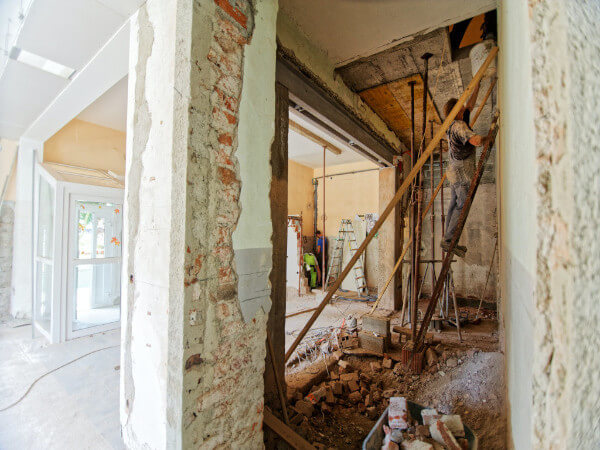
Lomans are an end-to-end installation company in the Netherlands who work today on the smart buildings and sustainable installations of tomorrow. They have all construction specialities under one roof: electrical engineering, mechanical engineering and smart buildings. Their market extends to all types of buildings and their focus is on the long, and therefore, sustainable term. Lomans are familiar with all phases of the installation process when it comes to construction projects – from the design phase to operations and maintenance keeping a clear vision on implementing sustainable, innovative, and creative solutions. With mechanical, electrical and plumbing specialists in one place, the team at Lomans have experience working on a range of projects extending from distribution locations and offices to residential accommodation.
Company growth and different ways of working
Lomans have approximately 400 employees with an estimated 250 colleagues working in the field on construction project sites. Over the last few years, the company has seen stronger growth with more and more projects being added to their portfolio. However, this expansion created some issues when it came to managing their day-to-day processes on projects. Bas Spaan, Data and Information Manager for Lomans, says: “With our company growth it soon became clear that there was no standardised approach to the way in which we implemented and used digital solutions on our projects. We have a number of different departments here at Lomans and many of them were working in entirely different ways.”
For Bas, managing project data and ensuring teams had access to the most up-to-date and accurate project information became challenging. “In some cases email became our single source of truth for the project teams at Lomans but this was not at always reliable nor sustainable.” At a minimum, Bas estimates that most of the project document was saved in at least two different locations – ranging from local network drives to different collaboration platforms and document sharing websites.
Lomans splits their company into customer teams who focus on the end-to-end project delivery processes. Working in this way means all project collaborators engage directly as one group – for example commercial, maintenance, engineering and bid teams, bring the overall construction process together smoothly. They work on a variety of big and small projects. “Our teams were collectively brought together in a deliberate move to focus more on the outcomes we deliver as opposed to the disciplines we belong to. However, this process showed us even more acutely that we needed better tools to support us to work more collaboratively and started our journey towards digitalisation,” affirms Bas.
Lomans were already using Revit, one of the design products in Autodesk’s AEC collection, for their 3D modelling and coordination. Bas found that Revit provided data rich models which provided vital project insights, but this important information was not always accessible to everyone on a project.
“With the exception of modellers, the wider team members were completely blind when it came to the insights they needed on our projects.”
—Bas Spaan, Data and Information Manager, Lomans
“So, we needed to find a way to better share important project data in a straightforward way that didn’t add too much time and complexity,” says Bas.
“Prior to implementing Autodesk’s Construction Cloud platform, Lomans worked with several manual processes. We had team members who printed off 3D drawings and worked in a 2D way using 3D information, which was clearly not the vision we wanted for the company,” says Bas. “The process was time consuming and lengthy and, team members couldn’t always be sure they had u accurate and up to date project information. Getting our hands on key project insight was more complex than simply looking at a drawing.”
Choosing the right solution
Over the last few years, Loman’s set out their 2030 future vision to focus on using cloud solutions for their construction project data to collaborate seamlessly internally and externally on projects. The team started using Autodesk Construction Cloud’s BIM 360 platform as their common data environment in 2019. “Our long-term plan has always been to align and use Autodesk Construction Cloud products so when Autodesk Build was launched, we knew that was the direction we wanted to travel in,” says Bas.
“We know that in the future we’ll be working differently with technology. Soon, the computer will be telling us the best way to work, not the other way round! We have realised that working in a cloud environment is a fundamental element to moving closer to this reality.”
—Bas Spaan, Data and Information Manager, Lomans
“Autodesk’s reputation in the market gives us the assurance we need that they are the right cloud software provider for us,” says Bas. “Seeing the capability of Autodesk’s cloud and the work they’re involved in when it comes to shaping the future of our industry, it was totally clear that this was the right company for us to work with.” For Lomans, other providers offered them an end point solution but not a solution that enabled collaboration between the design, construction, and operation phases of their projects.
Sprinting to standardisation
The team at Lomans began using Autodesk Build in early 2021. They started by rolling out the technology on a team-by-team basis. “We actually started with the least digitalised team at Lomans when it came to the rollout of Autodesk Build,” says Bas. Rather than implement the technology on all projects at once, Bas and the team introduced the technology by adopting a ‘sprint’ methodology. This allowed the team to get familiar using one particular digital workflow or process in depth at a time and then move on to the next process from there. “Rolling out the technology in this way helped to reduce disruption to our current projects and enabled us to learn from the cloud environment and from each other,” says Bas.
All new projects were implemented using Autodesk Build’s cloud environment. The first team to use the technology worked on small retail projects which were usually shorter in length than some of Lomans’s bigger projects. Bas reflects; “We could iteratively use the digital workflows and build our knowledge out bit by bit. We were also able to test some of the more complex workflows like markups and revisions on smaller projects and learn quite quickly about what did and didn’t work.”
Getting the basics right
By adopting this approach Bas and the team could quickly identify the best practices Lomans wanted to take forward. They started with getting the basics right with document management, then built on workflows like revisions, markups, checklists and issues management. “Using small steps and starting with the basics when it came to document management has meant that we’ve been provided with invaluable learning time,” says Bas.
The team at Lomans now use Autodesk Build for all new construction projects. Project data is structured in a standardised way which means any new team members joining an ongoing construction project know exactly where to go in their common data environment for the relevant information to get up to speed. Bas aims to be able to support construction teams use the permission sharing features when collaborating with external partners. This will remove the risk around data regulations and ensures the internal project team at Lomans can feel confident that the right people have access to the right information at the right time.
“We decided to use Autodesk Build for an annual process we carry out in our retail teams,” says Bas. “This involves emergency lighting checks for over 800 shops that we manage. Prior to implementing Autodesk Build, this was an entirely paper-based process which was not only time consuming but also risky, as important information could be lost during this process.”
Achieving the 2030 vision starts today
Looking to the future, Lomans plan to use more and more of the features and functionality that Autodesk Build offers including automating annual processes. Lomans are also investing in the optimal tools for their team when it comes to using Autodesk Build, which includes providing employees with laptops and smart devices. “The time our team has saved using the solution already has been immense,” says Bas. “Searching for documents is not only time consuming but also frustrating. The thinking that goes into this activity has also been removed,” reflects Bas. “Our teams can now focus on the value-added activities like making sure our projects are delivered to the best quality. We can also focus on more robust quality checks rather than wasting time on administrative tasks,” says Bas.
The vision for Lomans is that all projects will be live on Autodesk’s Construction Cloud and time will not be wasted searching for documents, looking for data or waiting for information to be provided. “For our team at Lomans, we’ve removed the need to search for documents on a project; they’ll be exactly where you need them to be,” states Bas.
For Bas, happy customers drive business growth so focusing on quality and implementing smarter ways of working will be invaluable for the team at Lomans. “Ultimately, our team’s expertise can be used to the best of their abilities. We can better support our customers to address their needs and solve their problems for improved outcomes,” says Bas.
The post Working In and With 3D Environments to Deliver Better Outcomes for Lomans’ Clients appeared first on Digital Builder.
Did you miss our previous article…
https://www.arizonasolarsociety.com/?p=1378
4 Ways to Avoid Profitability Traps That May Be Costing You
Maintaining profitability on any given project is a challenge that many AEC firms face. It’s no secret that the construction industry has some of the lowest margins out there; data from Camino Financial states that the construction industry has an average net profit margin of just 5%.
For this reason, teams are under immense pressure to meet project budgets. However, doing that can be a major challenge because construction projects face several profitability traps. These traps are present at all stages of a project and come in many forms—including inaccurate forecasting, data silos, lack of accountability, and so much more.

To avoid these pitfalls, teams must centralize their workflows, standardize their practices, and connect project data to critical processes. In doing so, you can improve productivity and reduce delay, which ultimately results in higher profits.
One firm that’s gotten good at avoiding these profitability traps is BL Harbert, a construction firm based in Birmingham, Alabama. BL Harbert brings in about $1 billion in annual revenue and employs 8,000 staff members across the globe.
Dane Pemberton, the firm’s US Group Construction Technology Manager, delivered an very helpful industry at AU 2021 where he discussed how BL Habert improved profitability by maximizing data and workflows
Dane spoke with Esteban Corrales, Manager of Technical Solutions for Construction at Autodesk, and outlined the steps that the company took to streamline its process and maximize profits.
1. Create efficient processes to eliminate bottlenecks
There are plenty of bottlenecks that can slow the progress of construction projects. It could be a case of stakeholders unable to quickly find the info they need. Other times, there’s a lack of alignment between teams.
Whatever the situation, bottlenecks cause delays, which lead to higher costs and lower profits. As Dane puts it, “Bottlenecks affect productivity. And if your productivity is affected, your profit margins are affected as well.”
“Bottlenecks affect productivity. And if your productivity is affected, your profit margins are affected as well.”
—Dane Pemberton, US Group Construction Technology Mgr, BL Habert
One of the best ways to overcome project bottlenecks is to get all stakeholders on the same page using a common data environment (CDE). Avoid using point solutions or disconnected systems, as this will create silos and reduce efficiency. Instead, centralize your data and workflows and ensure that teams can access everything they need from a single platform.
“Centralizing our model and pulling everyone into a common environment was really important to us,” explains Dane. “And so Autodesk Construction Cloud, and the unified platform it provides, has been key in helping us in our centralization effort.”
You can also eliminate bottlenecks through standardization. By making sure that teams follow the same procedures—and those processes are carried out on the same platform—you can keep things moving along more smoothly.
As an example, Dane shares their previous process for handling RFIs, which involved a lot of back-and-forth between various stakeholders.
“We would encounter an issue on the job, and then a superintendent would pick up the phone to tell the project manager. That person would then write the RFI and relay it to the vendor or subcontractor, who’ll use their own system and coordinate with other stakeholders. Then they’ll turn around, and send it back to us.”
The process was quite disconnected and left plenty of room for miscommunication. So, the company adopted digital tools which streamlined the RFI process.
“Now, with Autodesk Build and [Autodesk] Construction Cloud, we have a more concise workflow. We have at least a central source for all the data to live. We have the connected workflows inside of Build that help us take a pen off a sheet, immediately click on that, create an RFI, send that out.”
Dane continues, “And the tracking process is seamless. We send it to users that are already in the system. They get notified via email or notification on their phone. And they can immediately answer or share it with other team members. It has helped create efficiency through connecting all those workflows together, plus centralizing and standardizing what the RFI form looks like, and what the process looks like.”
2. Establish clear accountability across teams
Promoting accountability ensures that project tasks and milestones are met. When everyone knows what they’re responsible for—and they are empowered to fulfill those responsibilities—projects run smoothly and you fall into fewer profitability traps.
One way to achieve better accountability is to improve visibility within your projects. As Esteban points out, “When all teams have visibility into what others are doing and what they need to do to hit their schedule marks and their budget, it creates accountability into a shared project goal.”
So, how do you promote higher visibility for your teams? Dane recommends establishing consistent project inputs and processes.
“All of our projects teams typically have a senior leader or project executive assigned to multiple projects. And so what we found is [that] building consistency across our projects helped tremendously in reducing audit time.”
Dane adds, “Now that they have consistency, they know exactly what they’re looking at. They can go right to the things that make sense. We have common filters and common sorts, and we can leverage the database to give us the information in a consistent manner. And that’s been tremendous.”
When BL Harbert implemented more consistency in its projects, the company achieved better visibility of issues and action items.
According to Dane, “Now any issue or any action item that is generated on a job happens in one central location, and has one very similar look. And we can break those types down—i.e., if they’re a coordination issue, a safety problem, or a quality issue. We have all that at our fingertips.”
3. Digitally connect workflows and data to cost activities
We can’t talk about profitability without discussing cost management. Properly managing project expenses leads to wiser spending, cost savings, and—you guessed it—higher profits.
One of the best things you can do to improve cost management is to do it all from a centralized and connected platform. By connecting workflows and data to cost activities, teams can find important financial data much quicker, thus enabling them to make smarter cost-based decisions.
At BL Harbert, Dane shares that they connected Autodesk Construction Cloud with their ERP system, and this allowed them to unlock massive efficiency gains and profitability.
“It’s extremely important to have consistency, especially when you’re managing cost,” says Dane, who recalls how they used to manage their costs using Excel and other disconnected tools.
“We used to have an Excel spreadsheet to manage projections. We would have calculations off to the side on a sheet of paper. We’d have invoices in a different system, trying to backtrack and figure out where costs went or where something got coded.”
Now, the teams at BL Harbert use Autodesk Construction Cloud. “We built an integration to our ERP system, and we’ve connected all of those aspects together. And just by going through some clicks in the system, and drilling down on certain areas inside the Budget tab of the Cost module, we’re able to drill down to some of those things.”
“We don’t have to print out a dozen reports, and enter in a different job number to then go and pull an Excel file. So it’s been extremely valuable to connect all those workflows together. That one is probably one of the biggest efficiency gains, in and of itself, that we’ve seen.”
4. Analyze data to proactively mitigate risk
A key benefit of connected workflows is better data visibility. Armed with the right data, teams will be able to gain useful insights that they can use to mitigate risk. The teams at BL Harbert use Autodesk’s Insights tools to bring data together in one place, which helps them understand project health and potential risks.
They can, for example, use AI and machine learning to identify RFI risk factors and use those insights in their decision-making.
And according to Dane, this is just the beginning. They intend to double down on data so they can further leverage it to grow the business.
“One of our biggest goals for the future is expansion. We want to continue to grow our technology footprint,” he shares.
“We want to continue to grow our utilization. We want to take advantage of what we know we have inside these systems, and really leverage the analytics to resolve company problems.”
Is Autodesk right for your projects?
Low profits don’t have to be the norm in your construction firm. You can unlock extensive profitability gains by streamlining and connecting your processes, promoting accountability, and leveraging data.
Autodesk Build can help you do all of the above and more. Request a demo today and someone on our team will get in touch. We’ll talk through where you’re at, where you want to go, and how Autodesk Build can help you get there.
The post 4 Ways to Avoid Profitability Traps That May Be Costing You appeared first on Digital Builder.
October’s Nonresidential Construction Starts -26% M/M, -9% Y/Y & -2% YTD

October Handicapped by September’s Strength
ConstructConnect announced today that October 2021’s volume of construction starts, excluding residential work, was $28.8 billion (see shaded green box, bottom of Table 8 below), a decrease of -25.6% compared with September 2021’s level of $38.7 billion (originally reported as $38.0 billion).
![]()
5 Examples of Circular Economy Solutions in the Construction Industry

Circular economy solutions aim at establishing a sustainable model of production and consumption by optimizing resources and reducing and recovering waste (giving it a second life as a new product). Thus, by adopting these solutions, businesses can extend product lifecycles, reuse waste, and ensure a more sustainable production model.
![]()
Did you miss our previous article…
https://www.arizonasolarsociety.com/?p=1355
Mid-November Economic Nuggets, With a Focus on Mega Projects, Inflation, & Air Travel Statistics

Among ConstructConnect’s Top 10 project starts list for October are two that seem perfectly in sync with the times in which we’re living. For much of the past year-and-a-half, many of us have been cooped up at home as a precaution against contracting the coronavirus. Some of us have gone on fitness regimes; and we’ve all been aware, whether embracing it or not, of the extraordinarily swift breakthroughs made in vaccination protection.
![]()
Did you miss our previous article…
https://www.arizonasolarsociety.com/?p=1351
Construction Budgeting 101

Your construction budget is one of the most important things to get right in any project. Poor budgeting leads to inaccurate estimates and error-prone forecasts, which can result in unfavorable project outcomes.
The lack of proper budgeting practices can also lead to communication breakdowns and misalignment. When your team members can’t get on the same page on project spending, you’re more likely to run into design, construction, and admin errors.
Ultimately, an inadequate construction budget leads to cost overruns, wasted time, and lower profit margins. For this reason, it’s important to understand and implement cost management best practices. It also helps to equip your teams with tools that can help keep your project’s financials in check.
In this post, we’ll go over all these points to give you a better understanding of construction budgeting and how to implement it. You’ll walk away with a solid grasp of budgeting fundamentals, along with tips to help you maintain strong profit margins throughout the lifecycle of your projects.
Construction budget basics
To successfully create your budget, you need to have good data, a reliable team, and a thorough understanding of the scope of work. When these components are in place, you’re better equipped to come up with accurate budgets and estimates.
Have access to the right data
You need to get your hands on accurate and up-to-date data; otherwise, you won’t be able to produce reliable estimates and projections. To that end, strive to create easy access to the most recent and relevant data possible.
Work with strong team members
The people with whom you collaborate can have a massive impact on the amount of money and time you spend on a project. See to it that you’re working with a qualified team of contractors and subcontractors.
Build relationships with people who are honest, transparent, and good at communicating. In addition to ensuring that you get the most accurate figures, these types of individuals make collaboration much easier. You’re less likely to run into miscommunication, which helps to avoid issues such as misaligned expectations and change orders.
Iron out the scope
Scope out the work as thoroughly as you can. Conduct a proper site inspection, and don’t shy away from asking detailed questions before drawing up an estimate. Get down to the nitty gritty if you have to. For example, make it a point to verify any unit prices on the budget that you can. The more accurate your estimates, the more satisfied everyone will be with outcomes because expectations were better set from the beginning. For best results, work closely with all stakeholders to determine the objectives, timelines, and deliverables of the project.
It takes a bit more work up front, but spending this time and effort in defining a job’s scope will enable you to create a detailed and accurate budget that’ll serve you and your teams as you go through the project lifecycle.
Preconstruction budget planning
A lot of budget-related activities take place during the preconstruction phase, and for good reason. Effective budgeting means planning your expenditures in advance and allocating your resources accordingly. By managing your budget during preconstruction, you’re able to consider the entire building process before breaking ground, ultimately helping you mitigate risks and cost overruns.
How preconstruction budget planning works
Generally speaking, the preconstruction budgeting process involves the following steps.
Conduct initial meetings: Teams kick off a project by holding a meeting (or a series of meetings) wherein the client and contractor discuss the objectives and other details of the particular construction project. The client may share an initial budget or figure that they have in mind for the job.
Come up with project estimates: This figure isn’t set in stone. The contractor must evaluate the details of the project—including specifications, market rates, and historical costs—to determine whether or not it’s feasible to complete the job with the given amount. At this stage, the contractor also needs to consider factors like material costs, subcontractor and labor expenses, and other contingencies to figure out how much they’re likely to spend.
Implement value engineering: Teams can also implement value engineering—the practice of maximizing value by optimizing each project’s component in relation to the cost. Contractors implementing value engineering must assess the functionality or value of different aspects of the job and allocate resources accordingly.
For example, if a client values sustainability in their projects, the contractor could optimize the budget so that it allocates more resources to the components that make the building eco-friendly, while at the same time finding cost-savings in other areas.
Different types of costs to consider
During the preconstruction budget planning stage, the costs that contractors have to consider typically fall into the following categories.
Administrative: Admin expenses cover design and engineering costs, along with other activities related to the management of project affairs (e.g., securing permits, drawing up paperwork, etc.)
Labor: Specialty contractors and the site crew all need to be paid, so ensure that you properly account for labor costs in your budget.
Preparation of the site: Any expenses incurred as part of site preparation should also be considered. These costs may include demolishing existing buildings and removing debris from the site.
Supplies and equipment: Costs under this category include any materials, equipment, and supplies necessary to build the project.
Consider the entire lifecycle of a project
When planning your expenses, it’s important to think about the entire lifecycle of the project and determine how much of the budget will be spent at each stage.
Design: This stage largely involves architects and members of the design team working together to come up with models for the project. Once everyone has signed off on the plans and specifications, the next task is to list the required materials and expenses necessary to procure them.
Preconstruction: Before breaking ground, stakeholders must first ensure that the site is prepared for construction. At this stage, activities such as soil testing, site inspections, and plan reviews would take place. Once these steps are complete, the budget, design, and schedule will be finalized.
Procurement: At the procurement phase, the team secures all the materials, supplies, and equipment required to build the project.
Construction:This is the actual execution of the job. At this point, construction crews make it to the job site to work on the building.
Closeout: Once the building is complete, the project enters the closeout stage. The construction site will be cleared up, equipment rentals will be returned, and the crew will be demobilized.
Common construction cost overruns
Here’s a not-so-fun fact: cost overruns are quite common in construction. KPMG found that just 31% of construction projects come within 10% of the budget, which means the sizable majority of projects exceed their original budget.
You can prevent this from happening by being aware of the most common reasons behind construction cost overruns and taking steps to mitigate them.
Inaccurate project estimates
Inaccurate estimates during the preconstruction process can lead to mismatched expectations regarding the project scope. When you underestimate the time and money it takes to complete a job or activity, you may end up spending more resources than originally planned and go over your budget. This can also negatively impact owner-contractor relationships.
The best way to prevent this is to set realistic and data-backed budget expectations during the preconstruction phase. Collaborate closely with all stakeholders to come up with the appropriate figures and always rely on data when making calculations.
Design errors
Poorly designed, inaccurate, or incomplete plan models will inevitably lead to delays and unnecessary costs down the line. This is why it’s essential for owners and contractors to be on the same page when discussing the scope and objectives of the job. During the design stage, ensure that all stakeholders are kept in the loop with all updates and changes.
It also helps to use technology. Digital models are much easier to update compared to paper documents. What’s more, digital solutions such as construction project management software streamline collaboration, issue detection and resolution, and progress tracking.
Unaddressed design errors can be expected to manifest in costly rework if discovered in any phase following design.
Change order errors
Change orders take place when the owner or contractor implements modifications to the project after the models and budgets have already been approved. Change orders, which can come in the form of new specs, fixes, and requirements, lead to changes in the budget, and often take additional resources to carry out.
It’s not easy to avoid change orders, but you can take steps to plan for them. During the budgeting stage, allocate time and resources for changes or disputes. Construction software can also come in handy here, as there are applications that can simulate scope changes during the preconstruction phase. This will help you anticipate different possibilities and budget accordingly.
Administrative errors
Admin errors are another common cause of construction overruns. Tasks related to scheduling, securing permits, and accounting can be quite complex. And if they’re done manually, it’s common for inefficiencies to perpetuate due to human error..
One of the best ways to avoid admin mistakes is to streamline various activities using technology. Integrated construction solutions, for instance, can automate data entry from one system to the next. In addition, project management software can improve visibility of data for administrators and ensure the accuracy of project documents.
Site management errors
As far as construction projects go, a lot of the action takes place on the job site, as this is where projects come to life. As such, job sites have many moving parts—you have your crew, equipment, supplies, and more.
Failing to manage any of the above components can lead to on-site conflict, delays, and additional expenses. Fortunately, these issues are easily preventable with proper communication. Keeping everyone aligned on the project specs, timelines, and budget will lead to a smoother experience for all stakeholders. When everyone knows what needs to be done and when they need to do it, you have stronger accountability and worker performance on-site.
How to resolve these common cost overruns? Build a good team.
You can have the best tools, materials, and resources at your fingertips, but these things are only as good as the people using them. That’s why it’s important to bring in the right people for the job. Take the time to vet and investigate your subcontractors, particularly in areas like trust and safety. Doing so will enable you to build a strong team from the get-go.
Technology for budgeting
Budgeting for construction projects isn’t easy, and this is where technology comes in.
Whether you need to streamline data entry and cost calculations or require better visibility into the different components of your projects, there are several technology solutions that can assist your workflows.
Bidding and estimating
During the bidding and estimating stage, contractors and estimators gather the necessary project details to form an accurate estimate and submit a bid. This process involves developing quantity takeoffs, gathering material prices, equipment costs, and more.
Bid management and estimating technology is meant to support a smoother preconstruction process. Functionality will depend on who is using it, and there are good solutions in the market for owners, general contractors, and specialty contractors.
Good bidding and estimating technology should:
- Combine 2D and 3D quantification into a single solution to help you come up with highly accurate estimates and competitive bids.
- Quickly access drawing and model-based quantification workflows, so estimating teams can collaborate better.
- Connect builders and owners so both parties can implement a smooth bid and risk management process.
- Enable general contractors to discover specialty contractors, qualify them for projects, and manage invites and bid submissions.
- Enable specialty contractors to view, track, and handle all their bid invites from one place, so they can manage their workload and ensure that no job slips through the cracks.
Project management
Submittals
At the submittals phase, the contractor submits project documents (e.g. submittals package) to the architect and design team. The team will then review the package, and once approved, will share it with field teams.
Managing the submittals process is significantly more efficient nowadays with readily available technology. Without getting too into the weeds, good solutions use AI (algorithms) to read your specs and automatically pull action submittals, product data, and more. This makes generating submittal logs much easier by enabling teams to further streamline their process. They can efficiently coordinate and manage all submittals in a single submittal log in the cloud.
RFI Management
Much like submittals, managing RFIs is very important to budget given its impact on cost and schedule. According to Navigant Consulting Forum, a typical project receives an average of 796 RFIs. It can cost over $1080 to respond to each one of them. That means RFI’s on a single project could impact a project’s bottom line by up to $860,000.
Knowing that RFIs can incur such steep costs and create project delays while the RFI is being responded to, good RFI management solutions should help flag high-risk RFIs so you can prioritize which RFIs need action. RFI management software should also help you catch design issues earlier to improve handover from design to construction and avoid exponentially expensive design issues caught later in the process. Last, RFI software solutions can help you identify risk across multiple projects so you can proactively make decisions about how to handle RFIs before they pop up.
Cost management
Cost management is about controlling costs to keep a project’s budget on track. That’s often easier said than done, but remember that the goal is to stay within budget to achieve max profitability. Managing costs is necessary at all stages of a project and requires having systems in place to ensure that you’re meeting intended targets.
So, what does good cost management software do? It should make navigating cost-related decisions much easier by giving you the exact data you need, when you need it. That often equates to helping you create more dependable forecasts, make better decisions on tighter timelines, and ultimately, give you a stronger handle of a project’s financials at every phase.
To make all that possible, good cost management technology enables you to connect real-time project and field data with cost activities. This increases the viability of cost-related activities because you’re able to understand—and report on—the impact of these activities to your bottom line.
Considering how closely tied cost-activities are to schedule, project management software should also centralize your project schedules and better yet, allow you to connect schedule and cost data. This enables your team to connect the schedule with the entire project and share information instantly to prevent costly downtime or miscommunication.
Ready to level up your construction budgeting?
Construction budgeting can be an arduous task, but it doesn’t have to be.
You can take the stress and hassle out of budgeting and cost management if you work with metric-minded team members and communicate with them openly. You should also establish budgeting processes that are relatively simple to implement. No need to overwhelm your team if you’re just getting your budgeting practices sorted out. There will be an inevitable learning curve and it’s something everyone can benefit from. Finally, equip your teams with digital construction tools that can automate tedious tasks. You’ll promote collaboration, make better decisions, and provide better visibility into the impact of those decisions on construction budgets.
By taking these guidelines, you’ll be able to budget smarter, reduce cost overruns, and improve overall project outcomes.
If you’re looking for robust tools and a strong technology partner to help you improve your budgeting practices, check out Autodesk Construction Cloud. Find out why some of the world’s top construction owners and firms trust Autodesk to power their teams and projects.
The post Construction Budgeting 101 appeared first on Digital Builder.
Roofer’s Jobs and Qualities
Roofer is a career field that is an excellent option for individuals who enjoy building and working with their hands. Roofers have the skills and knowledge to fix roofs of all types. They also use various materials, such as metal, wood, or tile, to construct, repair, and install roofs. A roofer also specializes in emergency roofing and can be hired for various residential and commercial needs.

The best roofers are comfortable working on high-rise buildings and should have excellent maths and English skills. In addition, they must be able to read a building plan. They will also be good with their hands. As a roofing job, you’ll be working at a height and with a variety of materials. You’ll be working in the most extreme weather conditions, and you’ll be exposed to a variety of materials.
While roofers typically install new roofs, they also repair or replace damaged ones. To avoid water damage, roofers use various materials, such as asphalt, metal, and concrete. Roofing contractors also specialize in low-slope, steep-slope, and sustainable roofs. Besides installing new roofs, they also conduct regular maintenance and inspections. Ultimately, a roofer’s job is to keep a building safe and functional.
A roofer must understand that mistakes are bound to happen. Even the best roofing companies make mistakes from time to time. If they leave trash or damaged areas on the roof, that’s a sign of a poor job. A quality company will take care of any issues before they become problems. The roofer’s job will never cause any harm to your home siding or landscaping. They should also ensure that they don’t damage your windows or other parts of your home.
In addition to installing and repairing roofs, roofers also install metal flashing on steep-sloped structures. For example, they install step flashing around vent pipes and install a waterproof bitumen layer on steep-sloped roofs. A good roofing contractor will also place metal flashing around chimneys. And they’ll nail down roofing felt to cover the entire roof. So if you’re looking for a new roof for your home, consider hiring a roofing contractor in Irving.
If you’re looking for a roofer, you’ll need to find one with experience and a good reputation. In addition, you’ll want to find a licensed and insured roofing contractor or a general contractor who also works on roofs. When hiring a roofing contractor, make sure to ask them about their training and if they use subcontractors or employ employees. If you’re not sure, ask if the company hires a general contractor, as this will ensure that they are a licensed roofer.
Among all occupations, roofers are the most likely to suffer from injuries and illnesses. Although most people can install asphalt shingles, not all of them have experience with different styles. Many factors can make it safer for a roofer to work with various types of roofing materials. A general rule of thumb is that the more experience a roofer has, the higher the salary. It would be best if you also were sure to check references before letting a contractor work on your roof.
Roofing is a job that requires a lot of tools and experience. A qualified roofing contractor will know how to install different types of roofing materials and will provide you with a free estimate. You should always follow these guidelines to ensure that the roof is installed correctly and safely. If you’re hiring a professional, you’ll be in good hands. When choosing a roofer, make sure to choose someone with the proper training and experience.
Because roofing is usually a seasonal profession, roofers are rarely on the job during colder months. However, they are often required to work outdoors in all kinds of weather, from cold to hot. There’s also the risk of falling, as roofers have to be careful not to hurt themselves. Despite these risks, however, they must have an excellent balance to do their jobs safely. A good balance and the ability to climb high are essential.
50+ New Product Updates for Autodesk Construction Cloud
Discover the latest updates to Autodesk’s construction software
Our product team continues to pinpoint valuable ways to improve your favorite Autodesk products. I’m excited to share the launch of over 50 new feature releases and enhancements across Autodesk Construction Cloud products.
From creating higher quality designs to speeding up RFI workflows, the latest product updates within Autodesk Construction Cloud can be found below.
Jump to releases by product:
-
- Autodesk Construction Cloud Unified Platform
- Autodesk Build
- Autodesk BIM Collaborate
- Autodesk Takeoff
- BuildingConnected
- Bid Board Pro
- BIM 360
- Assemble
Autodesk Construction Cloud Unified Platform

* = features on both Autodesk Construction Cloud unified platform & BIM 360
Dashboards | Additional Partner Cards
Both Autodesk Construction Cloud Unified Platform and BIM 360 users now see new partner cards for Aespada, DAQS.io, Embneusys, Geometrid, Oculo, Pronovos, Safe Site Check In, Structshare, Viact.ai, and WakeCap.
Dashboards | Send Dashboard as Reports*
Both Autodesk Construction Cloud unified platform and BIM 360 users can now share data from a dashboard within Insight as a PDF report to any external team members. A great example of this is if a general contractor wanted to share a dashboard view with an owner who did not have an account. This broadens visibility into project data and allows teams to create custom dashboards and easily share relevant views. Note: PDF reports of dashboards do not include partner cards in this initial release.
Dashboards | Unified Account Level UI Enhancements
From within the Executive Overview dashboards within Insight, both Autodesk Construction Cloud unified platform and BIM 360 users now see a consistent UI to help indicate that all projects shown on this overview list are pulled from projects across both BIM 360 and ACC. This ensures that executives see a holistic view of all projects, regardless of the product used, and help improve the migration experience.
Desktop Connector | Non-Conforming File Validation*
Autodesk Construction Cloud unified platform and BIM 360 users now have the ability to select specific files, and put them through the naming validation tool to rename them in order to meet the project’s naming standard in Docs.
Desktop Connector | Right-click to Rename Files*
For any file, a user be able to right click and rename a file from Desktop Connector without needing to navigate to Docs in the web browser.
Files | Import/Export of Naming Standard*
As a project admin setting up the naming standard on a project, the admin now have the option to export a .xlsx template. They can also make adjustments to the naming standard attributes in MS Excel for ease of use and import to a single project or multiple projects.
Files | Improvements to ISE File & Folder Operations*
Autodesk Construction Cloud unified platform and BIM 360 users can now take advantage of ISO naming standards validation when moving or copying files from enforced to enforced folders and when making a file “current”. Additionally, users can now have their search results be a method to organize files for selection to move or copy to an enforced folder.
Files | Open and Edit DWG with AutoCAD (web app)
From within Files, users can now right click on a .dwg file type to open the drawing within the AutoCAD web app, exposing the use of native AutoCAD tools (viewing and editing). NOTE: Once the file is clicked, a new tab is opened, exposing the AutoCAD web interface.
Library | Search & Sort
There is a new search bar as well as the option to sort within the account level library in the Autodesk Construction Cloud unified platform. This makes it easier to find library components so that teams can use consistent practices and drive standardization across all projects.
Reports | Issue Summary & Issue Detail Filter by Custom Attribute
Autodesk Construction Cloud unified platform users can now filter both the Issue Summary and Issue Detail reports by any custom attribute. This allows teams to run more specific reports that are catered to the way individual companies track issues.
Reports | Logo Management
Project Admins can now customize the logo that shows up on reports by either selecting the account logo or adding in a net new logo. This allows teams to improve the branding of their reports and provide clarity of ownership when sharing reports externally.
Reviews | Add Custom Attributes to Workflows*
The project admin can now add custom attributes to a workflow so that each review initiated has the custom attribute columns for the approve to complete as needed. Note: For BIM 360 users, only projects created after Mar 23, 2021 will have this feature.
Autodesk Build
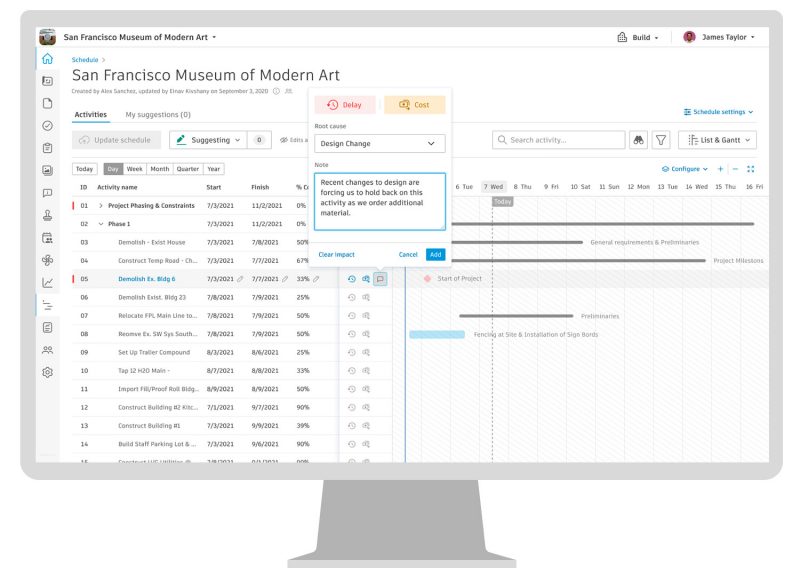
** = features in both Autodesk Build & BIM 360
*** = features in both Autodesk Build & PlanGrid
**** = Autodesk Docs feature (available across all unified products)
***** = features in both Autodesk Build and Autodesk BIM Collaborate
Note: This list is alphabetical. Please see this blog post for Autodesk Build updates organized by workflow.
Assets | Bulk Edits on Web & Mobile
Within Autodesk Build or the PlanGrid Build mobile app, teams can now make bulk edits to a selected group of assets by simply scanning barcodes, QR codes, or NFC tags in sequence. This allows teams to better standardize information and make updates faster.
Assets | NFC Support
In addition to using barcode / QR code scanning within the Assets tool of Autodesk Build, users can now use Near Field Communication technology to pull up detailed asset information. This saves teams time since they can simply set a device within range of the asset, and all asset related information stored within the PlanGrid Build mobile app will instantly appear.
Assets | RFI References
Within the Assets tool flyout panel, teams now see an added reference option for RFI’s. This means that users can link a specific asset to an RFI, connecting information and making it more accessible throughout both the assets and RFI workflow. Note: Mobile functionality will come by the end of the month.
Assets | Schedule References
Within the Assets tool flyout panel, teams now see an added reference option for Schedule. This means that users can link a specific asset to schedule item which gives visibility into where an asset status is in relation to the broader project schedule. Having this level of visibility helps teams better plan and forecast dates. Note: Mobile functionality will come by the end of the month.
Bridge | Automatic Sheet Sharing
As a follow up to the ability to share sheets across accounts (released in July 2021), team members can now specify certain sheets that they are sharing to automatically update when a new version is published. This ensures teams, even if they are from different companies or using different accounts, are always looking at the most up to date sheet information. NOTE: We are currently working on building up the feature functionality of the Bridge tool. Please watch for more enhancements to Bridge in future releases.
Bridge | Import Functionality
Within the ‘Incoming’ tab of Bridge, Autodesk Build users see a new option to ‘Import’ and select sheets from other projects, in which they are also a member, to add to their current project. This improves cross-team and cross-project collaboration, and gives users the ability to surface relevant information to their teams. NOTE: We are currently working on building up the feature functionality of the Bridge tool. Please watch for more enhancements to Bridge in future releases.
Cost Management | Enhanced Document Review Functionality**
Autodesk Build and BIM 360 Cost Management users can open and edit Microsoft Word documents online directly from the document package section within the items details flyout panel, enhancing and accelerating the document review processes.
Cost Management | Expense Photo References
Autodesk Build Cost Management users can now add photo references (e.g., delivery tickets, receipts, etc.) to expenses, ensuring accounting has what they need to process payments.
Cost Management | Home Page**
Autodesk Build and BIM 360 Cost Management users now have access to a new Home Page within Cost Management, displaying an aggregated calendar view of important dates across the system for increased visibility.
Cost Management | Issue to Potential Change Order
Expanding on the ability to create a Potential Change Order (PCO) from an RFI or Submittal Item, Autodesk Build Cost Management users can generate a PCO directly from Issue. Continuing to help teams capture the origin of change orders.
Data Connector | Photos Data
Autodesk Build users can now extract Photos data using the Data Connector. This is especially important to teams tracking quality and safety and wanting to see details around things like how many photos have been captured.
Data Connector | Progress Tracking Data
Autodesk Build users can now extract Progress Tracking data using the Data Connector. This gives teams the ability to create custom dashboards around the use of Progress Tracking and further analyze installation progress of objects on a project using other BI tools.
Handover | Files & Issues in As Built Export
Autodesk Build users can now export Files and Issues data as a part of the As Built Export tool. This adds to the RFI, Submittals, and Sheets download that was currently available and further improves the handover process by saving time, enhancing documentation accuracy, and improving owner satisfaction. Note: Files data will not be available until the end of November.
Issues | Add reference to submittals, forms, PCOs
In addition to the existing ability to link photos, files, RFIs and assets, user can now also add a reference to submittals, forms and PCOs, directly from the issue. This way, teams ensure even more of the issue’s context gets captured.
Meetings | Upload Attachments Directly from Computer*****
Users can upload and remove attachments directly from their PC. Attachments can be added at a meeting or at an item level. This ensures up-to-date information is shared and reviewed during the meeting.
RFIs | Roles and Companies as Users
Within each RFI, all roles and companies can now be specified as a watcher or co-reviewer. This release improves ease of use when creating, editing, or assigning RFIs.
RFIs | Short RFI Creation on Mobile
Users have the option to create an RFI by simply filling out the information for three fields: RFI title, question, and photos. This feature allows users to save time on RFI creation in the field.
RFIs | Step Back From Manager to Subcontractor
This feature allows RFI managers to request additional information from subcontractors by sending the RFI back to the sub. This release helps to speed up the RFI workflow by making sure necessary changes are made in a timely manner.
Schedule | Add Cost reference
Users can reference cost items from the cost management tool to an activity in schedule.
Schedule | Enhanced iOS support
iOS users can filter schedule information by Activity codes/ Outline codes imported from the schedule authoring tools. Allowing teams to find the right information, faster.
Schedule | Suggestions [coming soon]
Users with the right permissions can now submit an update suggestion on an activity to the schedule manager, improving communication across stakeholders. The schedule managers can review, approve or reject the suggestions. The schedule manager must update the master schedule in the schedule authoring tool to ensure the latest schedule is imported into Autodesk Build.
Submittals | Import Enhancements
During the upload process, Autodesk Build users get a new processing loader which can be referred to as a progress bar. This release supports a friendlier and more transparent import process.
Submittals | Project Home Support on Mobile
Users can now view a submittals work status card on iOS & Android. This allows access to critical and actionable information faster from any device at any time.
Submittals | Report Enhancements
From the Submittal tool, users can generate both the detail and summary reports, and have the option to include specific submittal items when exporting the report. Report enhancements now also include a single item report that can be generated from the action menu. Users can also copy a public link to share the report from the panel once the report has been generated. These enhancements allow customers to have more flexibility when exporting submittal reports.
Submittals | Review & Annotate PDF Attachments
Autodesk Build users now can view and annotate submittals, such as adding an approval stamp (image stamp), text, arrow, cloud, highlighter and various shapes directly in Autodesk Build. This enables a faster and more efficient review process.
Submittals | Upload Attachments from Files or from Computer
Autodesk Build users can select up to 10 existing files from Autodesk Docs and attach it to the specific submittal item. Now, Document Management and Project Management workflows are even more connected.
Learn more about this month’s product releases specific to Autodesk Build in this blog post.
Autodesk BIM Collaborate
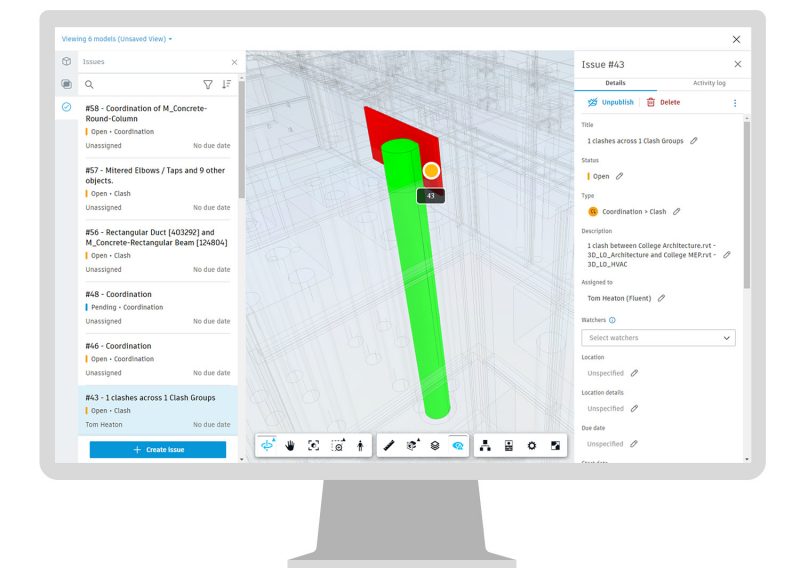
****** = features in both Autodesk BIM Collaborate and BIM 360
Change Analysis | Easier navigation
Design changes are now more easily managed and analyzed with a new experience that allows users to select the models they want to compare and quickly apply filters by discipline, category or modification type (shape, property, transform). Teams now have more control over the changes they decide to focus on and how those changes affect them.
Change Analysis | Review of non-consecutive designs
Previously, architects and engineers who review design changes before consuming them could only review the differences between the new design and the last design. Now, any design from the past can be reviewed alongside the latest.
Go Online | Revit Issues Add-In******
Architects, engineers, and BIM managers using Revit can immediately access issues, clash information, and models from cloud applications like Autodesk BIM Collaborate or Autodesk Docs. When an issue gets resolved in Revit, designers can use this quick link to access related files or check their work against other models using the clash matrix—making it easier to create high quality designs.
Model Coordination | Advanced grouping******
Group clash results with a greater level of granularity with advanced grouping capabilities. Now, clashes can be grouped by any property of a clashing object. Choose standard properties or custom ones to group and organize clashes for faster clearing and resolution.
Model Coordination | IFC, NWC, and VUE File Support******
With the added support of NWC and VUE files and extended support for IFC files for automatic clash detection or model aggregation, Autodesk BIM Collaborate offers greater flexibility for BIM managers, design teams, and trade partners to engage in model coordination.
Autodesk Takeoff
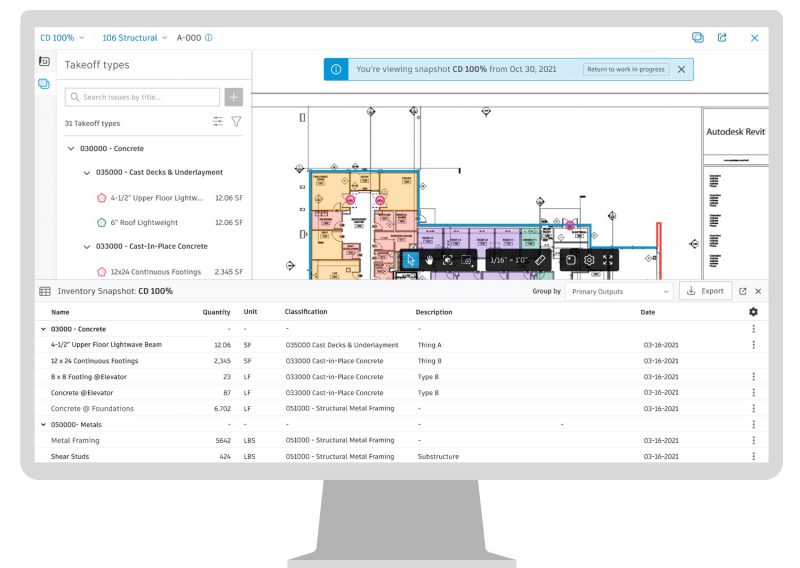
Snapshots
Autodesk Takeoff users can preserve critical information including sheets and/or models along with associated takeoffs and inventory within a project at a given point in time. Users can access saved snapshots to view prior versions of takeoffs and inventory for a specific milestone or other key events. These stored references provide estimators confidence in their work by citing key information critical to the takeoff detail.
Flexible Output for Takeoff Types
Users can assign a code from both primary and secondary classification system to any output (primary or unlimited “additional” outputs) when creating takeoff types. The classification field is now optional, allowing estimators to create takeoffs faster when needed. The outputs not classified are automatically grouped as “unassigned” to make it easier for users to track and reassign later if needed. Each output can be assigned up to 2 classification codes—one from each classification system uploaded.
Inventory Enhancement
Users can view information from both primary and secondary classifications at the same time in the inventory panel. Multiple outputs can be seen together, grouped by takeoff type, when appropriate. A new grouping has been created in the inventory for “unassigned” outputs. Location information is also surfaced in the inventory panel.
Locations Support
Users can assign takeoffs to specific locations created in the “Project Admin” tool so quantities can be assigned accordingly. Whether you are allocating quantities by Floors, Levels, Phases or Zones, locations are a great way to organize your takeoff inventory.
BuildingConnected
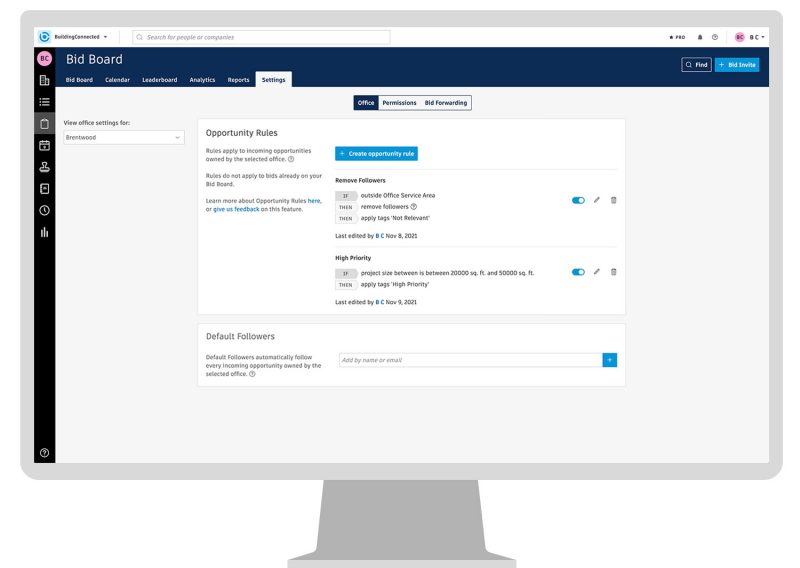
Bid Board Pro
Opportunity Rules
Users can create opportunity rules (“if/then” statements) to help organize opportunities and filter out junk invites by either applying tags or removing followers. This helps to streamline the Bid Board experience and remove unwanted invites automatically.
BIM 360
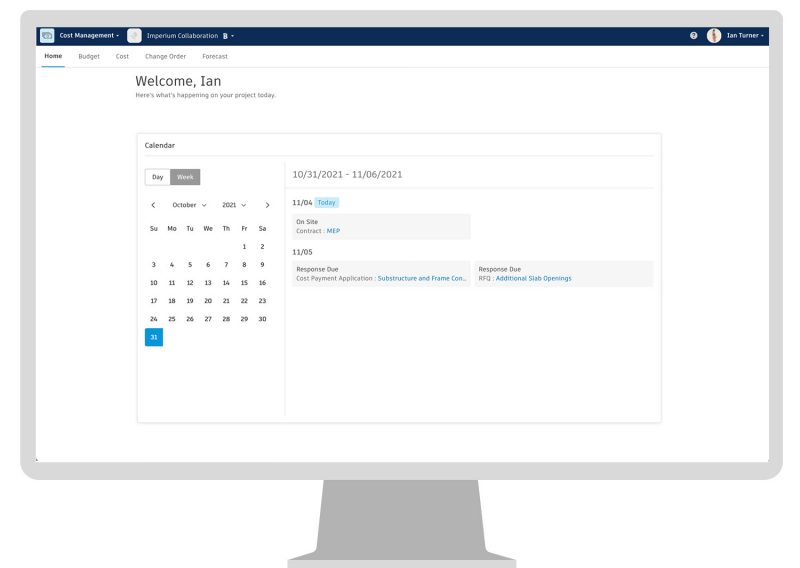
****** = features in both Autodesk BIM Collaborate and BIM 360
Daily Logs | XLS Report from Field Management******
BIM 360 users can now export the activity log of any daily log. The export includes timestamp, user, activity and before after status which makes it a full audit trail useful in case any disputes arise.
Dashboards | Permission Changes******
BIM 360 users can now control permission to view certain dashboards within BIM 360. This helps drive focus for team members and eliminate unnecessary dashboard views. Additionally, it gives more control to Project or Account Admins to filter only relevant information to team members. For more information view the FAQ on our Help Site.
Assemble
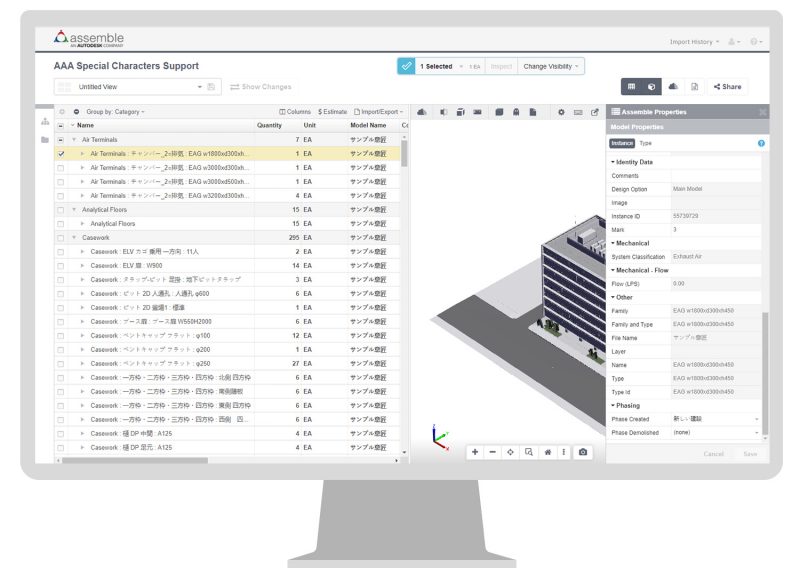
Expanded Support for Special Characters
Assemble has expanded support for Unicode characters for property names and values. Assemble users can now publish model properties names and values with expanded characters from desktop tools as well as Revit models from BIM 360 and Autodesk Docs. Users are also able to sync property values with expanded characters back to Revit.
Model Publishing Improvements
Continuing to build upon the recent enhancement of publishing Revit models from BIM 360 and Autodesk Docs to Assemble without the need of the Revit add-in, Assemble now supports importing Revit Cloud Workshare models as part of the cloud publishing workflow. By leveraging the common data environment, BIM/VDC Managers can ensure that everyone is working from the latest project documents.
Get the latest Autodesk Construction Cloud product updates

The post 50+ New Product Updates for Autodesk Construction Cloud appeared first on Digital Builder.